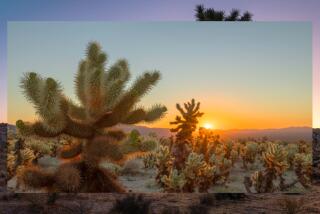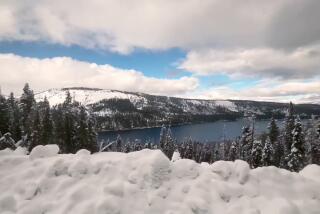Hiking the Sierra with three llamas and a baby
I wouldn’t call it a vacation, exactly. Any time you have three pet llamas and a 3-year-old and you’re covering 30 miles in less than a week, it’s like, well, let’s call it an adventure.
My wife, Amber, and I and our high-energy daughter Ediza spent a week in early August exploring the breathtaking terrain between the Mammoth Lakes area and Tuolumne Meadows in Yosemite National Park. The adults got a chance to experience the high-elevation landscape through a child’s eyes: sledding down a mound of snow on a sleeping pad, pretending to fish with a stick, collecting feathers along the trail, assigning names to the ants crawling on the ground.
“This is a magical land,” Ediza tells me.
And she’s right. This is the natural world in its finest form: sparkling lakes, snow-capped peaks, colorful wildflowers and, at night, howling wind and shooting stars.
Not to say our trek was always easy and peaceful. After all, backpacking with a spirited young child can involve sassiness and even tantrums, sometimes even by the kid.
Planning our trip
Backpacking permits for the Inyo National Forest are free and can be picked up starting at 11 a.m. at the Mammoth Lakes Welcome Center, 2510 Highway 203, Mammoth Lakes; (760) 924-5500, https://www.visitmammoth.com. The center has a large selection of books and maps, and backpackers can rent bear-proof cans to store food in. Open 8 a.m. to 5 p.m. daily.
Walk-in permits are free and can be picked up at the Welcome Center starting at 11 a.m. the day before departure. Space is limited. Backpackers can also reserve up to six months in advance at $5 a person but must still pick up their permit. Call Inyo National Forest’s Wilderness Permit Office, (760) 873-2483, for information.
The shuttle bus runs 7 a.m. to 7 p.m. daily from about mid-June until mid-September. Day passes can now be purchased at the Minaret Vista Entrance Station for $10 a vehicle, or $20 for a three-day pass.
To learn more
Inyo National Forest, https://www.fs.fed.us/r5/inyo
On the trail, we had to be resourceful and creative. In our most desperate moments we bribed her with candy or, as a last resort, warned her that if she didn’t behave a bear might pay us a visit.
The hike actually started with a mini-meltdown as we left the trailhead at Agnew Meadows. Ediza didn’t understand why she couldn’t walk a llama by herself in the busy parking lot.
The day before, I had picked up our free wilderness permit at the Mammoth Lakes Welcome Center. On the morning our hike began, we arrived at the Minaret Vista Entrance Station near the Mammoth Mountain ski area.
We paid $7 an adult, plus $4 for Ediza, to enter and drive the three miles to Agnew Meadows. If arriving at the entrance station between 7 a.m. and 7:30 p.m., most visitors are required to take the shuttle bus to limit traffic on the narrow road. (Shuttle buses stopped operating Sept. 8, the end of the summer season. Now, day passes can be purchased for $10 a vehicle.) Because llamas aren’t allowed on shuttles, they let us drive to the trailhead.
Our friend dropped us off at Agnew Meadows, where we sorted through gear before walking three miles to Shadow Lake. We then met up briefly with the John Muir Trail, before veering off to our daughter’s namesake, Lake Ediza.
The High Sierra lake, deep in the Ansel Adams Wilderness of the Inyo National Forest, sits below the stunning Minarets on one side and Banner Peak and Mt. Ritter on the other.
Ediza helped me pitch our tent and assisted her mom with cooking pasta for dinner.
We camped two nights above the snowmelt lake at an elevation of 9,300 feet.
Hordes of mosquitoes wanting to suck our blood detracted from the lake’s beauty. Those pesky insects still couldn’t prevent Ediza from running around and trying to climb the tall granite surrounding us.
This was Ediza’s fourth visit to “her” lake. The first was when she was only 8 months old and slept calmly in her carrier.
Now, she’s old enough to ride a llama.
The three llamas we were hiking with are from the farm we live on in the Sierra foothills. The beasts of burden are gentle, curious and make it possible to go comfortably into the mountains with a young child. (As with all pack animals, the llamas must be listed on the wilderness permit. There are some grazing restrictions.)
All three llamas carried our gear and food in packs, and our llama, Golden, carried Ediza for most of the hike. When she’s not on its saddle, she’s on my back in her almost-outgrown carrier.
On the trail, Ediza was in her element as she rode Golden effortlessly and soaked up the views.
Leaving Lake Ediza, we hiked back to the John Muir Trail, which would take us all the way north to Yosemite.
Five years ago, Amber and I had hiked the John Muir Trail, which spans 212 miles from Yosemite to Mt. Whitney (most of that trip was with two of the llamas we brought on this hike). That hike turned out to be a three-week date and eventually led to our getting married and starting a family.
Which brought us to our most recent hike this summer.
We walked north on the John Muir Trail, past Garnet Lake and then on to popular Thousand Island Lake. There, we camped and, as a special treat for dessert, ate dehydrated dark chocolate cheesecake (which tastes more like pudding in a bag, but I’m not complaining).
The next morning, we hiked from Thousand Island Lake to the eastern side of Donohue Pass, where we spent the night camped next to a tiny waterfall. Ediza befriended a playful marmot and created imaginary forts under clusters of pines.
A vibrant blue sky created the perfect backdrop for patches of green grass dotted with purple lupines and red Indian paintbrush.
The next day, we climbed up and over 11,056-foot Donohue Pass, crossing streams and snow.
Ediza rode Golden up the eastern side of the pass, but once we crossed into Yosemite at the top, the trail got too rough so on my back she went.
Once in Yosemite, we witnessed plenty of wildlife: birds soaring in the sky, snakes slithering through the tall grass, butterflies fluttering by, tiny frogs hopping along the trail.
We also encountered many more people when compared with the relative isolation of the national forest.
Yosemite can be circus-like, as people surrounded us with their cameras and peppered us with questions. Every other hiker stopped to take pictures of Ediza on Golden.
We passed plenty of sweaty, exhausted people with huge backpacks who were envious of the llamas carrying our gear.
“I am coveting your llamas,” one backpacker said as she hiked by us during one of our many breaks.
Llamas can’t carry adults (only kids), but they can help lighten the load of a backpack or eliminate it altogether. Amber and I each wore light backpacks.
Hiking with children and animals, we found, is an exercise in patience. You must take your time, go with the flow and try to make sure everyone’s needs are met.
After camping one final night, we made our way to Tuolumne Meadows — the place to be in Yosemite during the summertime. Although still busy, this high-country paradise doesn’t compare to Yosemite Valley and its crowds.
Walking out our last day to get picked up, the weather was cool and breezy with thunderstorms approaching.
We saw a baby deer prance in front of us along the trail. A few seconds later, the mother deer came running along.
“Some things are universal,” I said to myself, assured that we weren’t the only ones chasing after a youngster in the wilderness.
travel@latimes.com
More to Read
Sign up for The Wild
We’ll help you find the best places to hike, bike and run, as well as the perfect silent spots for meditation and yoga.
You may occasionally receive promotional content from the Los Angeles Times.






